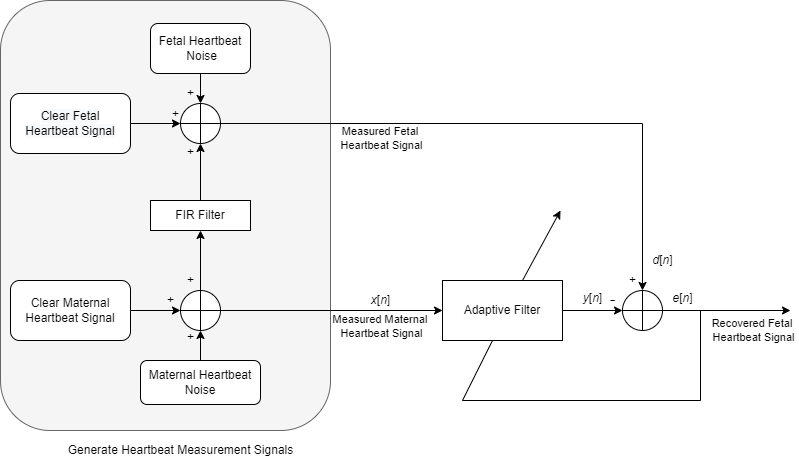Apply Adaptive Noise Canceling to Fetal Electrocardiography
Apply adaptive filters to noise removal using adaptive noise canceling (ANC) in fetal electrocardiography.
Introduction
In adaptive noise canceling, a measured signal d(n) contains two signals:
Unknown signal of interest v(n)
Interference signal u(n)
The goal is to remove the interference signal from the measured signal by using a reference signal x(n) that is highly correlated with the interference signal. The example considered here is an application of adaptive filters to fetal electrocardiography, in which a maternal heartbeat signal is adaptively removed from a fetal heartbeat sensor signal. For more information about adaptive filters and their applications, see Overview of Adaptive Filters and Applications. This example is adapted from Widrow, et al, "Adaptive noise canceling: Principles and applications," Proc. IEEE(R), vol. 63, no. 12, pp. 1692-1716, December 1975.
The following block diagram illustrates the use of adaptive filters to perform noise removal from fetal heartbeat signals.

Creating the Clear Maternal Heartbeat Signal
In this example, we shall simulate the shapes of the electrocardiogram for both the mother and the fetus using a signal that has a sample rate of 4000 Hz. The heart rate of this signal is approximately 89 beats per minute, and the peak voltage of the signal is 3.5 millivolts.
Creating the Clear Fetal Heartbeat Signal
The heart of a fetus beats noticeably faster than that of its mother, with rates ranging from 120 to 160 beats per minute. The amplitude of the fetal electrocardiogram is also much weaker than that of the maternal electrocardiogram. The example creates an electrocardiogram signal corresponding to a heart rate of 139 beats per minute and a peak voltage of 0.25 millivolts for simulating fetal heartbeat.
The Measured Maternal Electrocardiogram
The maternal electrocardiogram signal is obtained from the chest of the mother. The goal of the adaptive noise canceller in this task is to adaptively remove the maternal heartbeat signal from the fetal electrocardiogram signal. The canceller needs a reference signal generated from a maternal electrocardiogram to perform this task. In addition, we shall add a small amount of uncorrelated Gaussian noise to simulate any broadband noise sources within the measurement that can be controlled from the user interface.
The Measured Fetal Electrocardiogram
The measured fetal electrocardiogram signal from the abdomen of the mother is usually dominated by the maternal heartbeat signal that propagates from the chest cavity to the abdomen. We shall describe this propagation path as a linear FIR filter with 10 randomized coefficients. The addition of this FIR filtered maternal heartbeat signal introduces the correlation between measured signal and the reference signal which makes an adaptive filter suitable to remove the inference signal. Just like the maternal electrocardiogram signal, the fetal electrocardiogram signal also contains some additive broadband noise that can be controlled from the user interface.
Applying the Adaptive Noise Canceller
The adaptive noise canceller can use any adaptive procedure to perform its task. For simplicity, we shall use the least-mean-square (LMS) adaptive filter with 15 coefficients and a step size of 0.00007. With these settings, the adaptive noise canceller converges reasonably well after a few seconds of adaptation.
Recovering the Fetal Heartbeat Signal
The output signal y(n) of the adaptive filter contains the estimated maternal heartbeat signal, which is not the ultimate signal of interest. What remains in the error signal e(n) after the system has converged is an estimate of the fetal heartbeat signal along with residual measurement noise. Using the error signal, you can estimate the heart rate of the fetus.

Example Architecture
The command adaptiveNoiseCancellationExampleApp launches a user interface designed to interact with the simulation. You can control the measurement noise in the maternal and fetal heartbeats from the interface. It also launches a time scope to view the measured fetal heartbeat as well as the measured maternal heartbeat and the extracted fetal heartbeat.

Using a Generated MEX File
Using MATLAB Coder™, you can generate a MEX file for the main processing algorithm by executing the command HelperAdaptiveNoiseCancellationCodeGeneration. You can use the generated MEX file by executing the command adaptiveNoiseCancellationExampleApp(true).